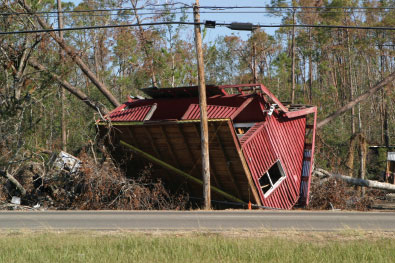Editor’s note: This week, we’re marking the 10-year anniversary of Hurricane Katrina with a pair of posts about how the Roosevelt community pitched in to help after the tragedy.

Connie Goddard, director of field placements and partnerships in the College of Education, volunteered during the winter break in storm-ravaged Louisiana.
Last September, a few weeks after Hurricane Katrina devastated New Orleans, my colleague Andy Carter, who is a Louisiana native and an assistant professor of mathematics education at Roosevelt, spoke at a University town hall meeting on how we could respond to the disaster.
Soon after, two other College of Education colleagues, Judy Gouwens and Sheila Coffin (see accompanying story), organized work trips with students to Bay Saint Louis, Miss., an area hard hit by Katrina. Then, sometime in mid-October I phoned Carter, asking him for information on an organization he had suggested we could help.
Thus began my involvement with the Southern Mutual Help Association (SMHA), a group based in New Iberia, La., and its Rural Recovery Task Force, which was established right after Hurricane Rita wreaked damage on parts of Texas and southwestern Louisiana, including parishes near New Iberia. I spent a week during the recent winter break helping SMHA’s cleanup efforts, and one of the things I learned is how a hurricane travels: its winds circle counterclockwise, picking up the ocean’s water on its western, downward thrust, then dumping water on its eastward side as the winds surge upward. In the area we worked, the waters rose from a few inches to waist-deep in less than an hour.

Many homes were toppled in Bay Saint Louis, Miss., which was near the eye of the Hurricane Katrina storm path.
“If you have to be in a hurricane,” noted one longtime resident, “you want to be on its west side, because it gets less flooding.” His house was one of a half-dozen the crew I worked with readied for restoration. We’d been directed there, in southern Vermillion Parish a few miles from the gulf, by SMHA, which, since the hurricane hit, has been organizing volunteer groups to first survey and then begin repairing damage, particularly to homes.
Signs of this project’s ecumenical nature were as abundant as the flood waters and the hardy outlook of the people devastated by them. SMHA, established by Catholic nuns to help sharecroppers emerge from dependence and poverty during the 1960s, had housed Unitarians from rural Vermont and Jews from suburban Boston in a Methodist church dining hall converted to sleeping quarters with bunk beds constructed by Canadian Mennonites. Many of our tools and cleaning supplies were provided by members of the Church of Latter-Day Saints.
Our project was to pull, peel and pry wallboard, cupboards, linoleum and appliances away from the structural elements of a half dozen modest homes. For four days, two dozen of us wielded crowbars, sledgehammers and saws to get the job done. Along the way, homeowners affected by the disaster worked with us, while others, including a physically disabled man, could offer little more than moral support. One woman told us it would have taken a month or more to do the job on her own.
Service like this not only continues the tradition of social justice that Roosevelt lays claim to; it helped us, too, as we developed skills we did not know we had.
We also enjoyed ourselves—Acadians are famed for food and good times—and had several invitations to dinner, but we departed knowing there was much left to do. Service like this not only continues the tradition of social justice that Roosevelt lays claim to; it helped us, too, as we developed skills we did not know we had.
Leave a Reply